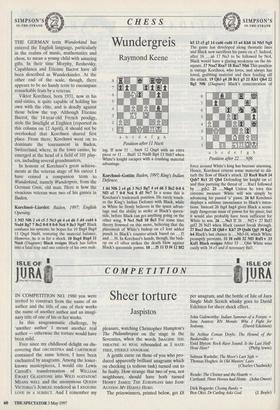SIMPSON'S
IN-THE-STRAND
SIMPSON'S
IN-THE-STRAND
CHESS
Wundergreis
Raymond Keene
THE GERMAN term Wunderkind has entered the English language, particularly in the realms of music, mathematics and chess, to mean a young child with amazing gifts. In their time Morphy, Reshevsky, Capablanca and Etienne Bacrot have all been described as Wunderkinder. At the other end of the scale, though, there appears to be no handy term to encompass remarkable feats by a veteran.
Viktor Korchnoi, born 1931, now in his mid-sixties, is quite capable of holding his own with the elite, and is deadly against those below the top. Although Etienne Bacrot, the 14-year-old French prodigy, stole the limelight at Enghien (reported in this column on 12 April), it should not be overlooked that Korchnoi shared first place. From there, Korchnoi went on to dominate the tournament in Baden, Switzerland, where, in the town casino, he emerged at the head of a field of 101 play- ers, including several grandmasters.
In honour of Korchnoi's great achieve- ments at the veteran stage of his career I have coined a companion term to Wunderkind, namely Wundergreis, from the German Greis, old man. Here is how the vivacious veteran won two of his games in Baden.
Korchnoi-Liardet: Baden, 1997; English Opening.
1 Nf3 Nf6 2 c4 c5 3 Nc3 g6 4 e4 d6 5 d4 cxd4 6 Nxd4 Bg7 7 Be2 0-0 8 0-0 Nc6 9 Be3 Ng4? Black confuses his systems; he hopes for 10 Bxg4 Bxg4 11 Qxg4 Nxd4, restoring the material balance. However, he is in for a shock. 10 Bxg4 Bxg4 11 Nxc6 (Diagram) Black resigns Black has fallen into a fatal trap and one entirely of his own mak-
ing. If now 11 bxc6 12 Qxg4 with an extra piece or 11 ...Bxdl 12 Nxd8 Bg4 13 Nxb7 when White's knight escapes with a crushing material advantage.
Korchnoi-Gottin: Baden, 1997; King's Indian Defence.
1 d4 Nf6 2 c4 g6 3 Nc3 Bg7 4 e4 d6 5 Be2 0-0 6 NO e5 7 0-0 Nc6 8 d5 Ne7 In a sense this is Korchnoi's trademark position. He rarely touch- es the King's Indian Defence with Black, while as White he firmly believes in the space advan- tage and the ability to strike at Black's queen- side, before Black can get anything going on the other wing. 9 Nel Ne8 10 Be3 For some time theory frowned on this move, believing that the placement of White's bishop on e3 lent added punch to Black's counter-attack based on ...f5 and ... f4. In Korchnoi's hands, though, the bish- op on e3 often strikes the death blow against Black's queenside pawns. 10 ...f5 11 f3 f4 12 Ilf2 h5 13 c5 g5 14 cxd6 cxd6 15 a4 Kh8 16 Nb5 Ng8 The game has developed along thematic lines and Black now sacrifices his pawn on a7. Indeed, after 16 ...a6 17 Na3 to be followed by Nc4, Black would have a glaring weakness on the b6- square. 17 Nxa7 Rxa7 18 Bxa7 Nh6 This position is vintage Korchnoi, who loves, and always has loved, grabbing material and then fending off the attack. 19 Qb3 g4 20 Rcl g3 21 Khl Qh4 22 Bgl Nf6 (Diagram) Black's concentration of a bc de f gh Position after 22 . . . Nf6 force around White's king has become alarming. Hence, Korchnoi returns some material to dis- turb the flow of Black's attack. 23 RxcS %Ea 24 Qxb7 Ra 25 Qb4 Defending his knight on el and thus parrying the threat of ... Rxel followed by ...ph2. 25 ...Nhg4 Unless he tries this extreme measure White will win simply by advancing his passed `a' pawn. 26 h3 Korchnoi displays a sublime insouciance to Black's inten- tions. Instead 26 fxg4 hxg4 gives Black a seem- ingly dangerous mass of pawns for his piece, but it would also probably have been sufficient for White to win. 26 ...Ne3 If 26 ...Nf2+ 27 Bxf2 gxf2 28 Nd3 when Black cannot break through. 27 Bxe3 fxe3 28 Qb8+ KW 29 Qxd6 Qg5 30 Kg1 h4 Black's last chance is ... Nh5-f4, which White promptly prevents. 31 f4 exf4 32 NO Rxfl+ 33 Krill Black resigns After 33 ... Qh6 White wins easily with 34 e5 and if necessary Bd3.


































































 Previous page
Previous page